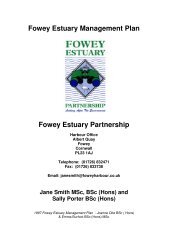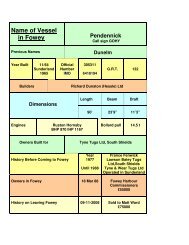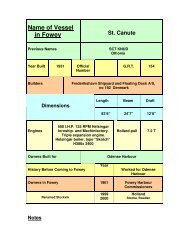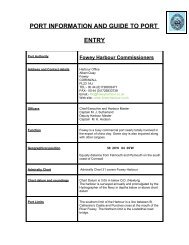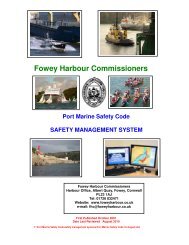TOWAGE GUIDELINES PORT OF FOWEY - Fowey Harbour
TOWAGE GUIDELINES PORT OF FOWEY - Fowey Harbour
TOWAGE GUIDELINES PORT OF FOWEY - Fowey Harbour
Create successful ePaper yourself
Turn your PDF publications into a flip-book with our unique Google optimized e-Paper software.
Towage Guidelines<br />
To ensure that towage is carried out to an agreed standard, the following<br />
guidelines have been produced by <strong>Fowey</strong> <strong>Harbour</strong> Commissioners in<br />
consultation with <strong>Fowey</strong> Pilots Association, Tug Masters, Ships Agents and<br />
Imerys Ports. These are produced with safety in mind.<br />
They are published for users’ guidance, supporting the port operations<br />
manual and <strong>Harbour</strong> Masters Directions and Notices.<br />
The Guidelines provide a safe working framework for the movement of larger<br />
vessels and disabled vessels using the port, or vessels as directed by the<br />
<strong>Harbour</strong> Master.<br />
Because of length restrictions and on occasions because of draft or lack of<br />
manoeuvrability, vessels will be directed to take tugs following risk<br />
assessments.<br />
These guidelines are based on using the following towage assets<br />
Morgawr 23.5 tonne B.P<br />
Tregeagle 15 tonne B.P<br />
Penleath 4 tonne B.P<br />
“Morgawr” is a Voith tractor with full Lloyds certification for coastal towage and<br />
maximum towage capabilities. The remaining assets are all conventional<br />
drive and steering and are best suited for straight tows and passive escort.<br />
These vessels may be employed for moves dependant on type, tug<br />
availability and duty required.<br />
<strong>Fowey</strong> is a narrow deep water port with 5 commercial berths. Modern vessels<br />
up to 95m LOA may turn around in Mixtow Reach if weather, tidal and port<br />
conditions permit. Due to the width in the river off the jetties and in particular<br />
in this location, there is insufficient “turning room” for vessels in excess of this<br />
size to turn unassisted. They are therefore turned in the lower harbour and<br />
towed stern first to their berths.<br />
Once inside the harbour, sheltered conditions prevail with the wind being<br />
funnelled north/south due to the high land immediately adjacent to the<br />
harbour. Strong tidal flows, especially on ebb tide and after heavy rain can be<br />
experienced.<br />
Vessels with bow and stern thrusters in good working order, together with<br />
high lift schilling type rudders may be given exemptions from the use of some<br />
tug numbers set out in the guidelines. Weather conditions and other vessels<br />
in port may also affect the application of the guidelines. Tug support may be<br />
directed when the use of the supporting tug is at the Masters/Pilots discretion.<br />
T:\<strong>TOWAGE</strong>\towage guidelines\2010\towage guidelines 2010 jan.doc<br />
Reviewed Jan 2010



